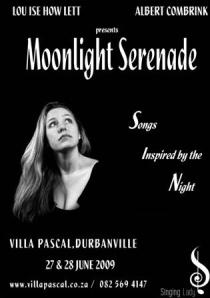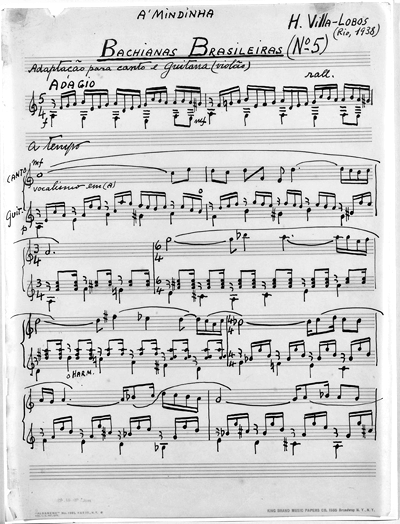
Bachianas #5 will be performed in "Moonlight Serenade" and is recorded by Louise Howlett on her latest CD
Louise Howlett and I will be performing the Bachianas Brasileiras #5 by Villa-Lobos in our new Moonlight Serenade programme. We have recently recorded this for release on our upcoming CD and spent a very intense few hours in the studio experimenting with different performing styles and “versions”. I am also preparing a performance of this work with Filipa von Eck for a concert in Mozambique which will commemorate the 50th anniversary of Villa-Lobos’s death. The work is so popular and well-known that I thought performing it would be relatively straight-forward. I knew it so well. Or at least, I thought I did.
Brazilian Heitor-Villa Lobos (1887-1959) is one of the most significant Latin Composers to date. He wrote works in many different styles: orchestral, instrumental, small chamber ensembles, songs and more. His music is influenced by Brazilian folk music, but he is considered a composer of classical music. A set of 9 Bachianas Brasileiras aim to combine his love for the music of his country with homage to the work of J.S. Bach. Villa-Lobos is said to have found analogies between Bach’s works and the traditional music of Brazil.
Originally written for soprano and eight-part cello ensemble, the “Bachiana #5” is very often performed incomplete. The first section, the Aria (Cantilena) composed in 1938, is often performed on its own. Its hauntingly beautiful melody has made it extremely popular and the second part, Dança (Martelo) added in 1945 is often omitted. The Aria opens with pizzicato cellos, their plucking sounds reminiscent of a large, resonant guitar. The voice enters with a melody so exquisite and haunting that it stays with you forever. And no matter where you hear it, the reaction to its beauty is instant.
Its shape is simple: A long mellifluous melody flanks a more dramatic middle section, creating an A-B-A structure similar to a Braoque “Da Capo aria” that Bach might have written. If one accepts that melody is the essence of music, and that the essence of melody is song, then one can easily see the connection between the worlds of J.S. Bach and Heitor Villa-Lobos. Melody was always apparent in the works of Bach, and not a strict or rigid type of melody, but a fluid, rhapsodic and improvisatory kind – much like many types of folksong. And in the works of both composers, the feeling of the dance is never far away. The text to the middle section was written by Ruth Valadares Correa, and is a beautiful evocation of the beauty of the moon – therefore it was an obvious choice for our “Moonlight Serenade”. But the largest part of this work has no text. The singer just sings an exquisite melody without words, a vocalise to move the listener to their core.
The difficulties with performing this work appear when you try to do it without the orchestra of cellos. Most piano versions of music originally written for orchestra, are designed to make the music “performable” without an actual orchestra. Many tricks are used by editors to imitate the sounds one would expect to hear. Tremolos, runs up and down the piano to create washes of sound, or thundering chords held in the pedal, all in an attempt to delude the listener into forgetting that the eighty-piece orchestra has been replaced by ten fingers. The problem is that a piano creates vastly different sounds to seven plucking cellos.
Villa-Lobos himself created a piano version in 1948, mainly to satisfy his publishers, who needed something they could sell easily. The work was an instant popular success and singers wanted to learn and perform it, but weren’t always in a position to provide the cello orchestra. I have searched high and low for a recording of this version, but the lack of recordings of this version bears out my impression that this was not a version for serious performance, but rather a transcription to assist a singer in learning it. Sensible and sturdy chords give no hint of the flutter of butterfly wings created by the cellos.
Villa-Lobos had also worked extensively with guitarist Andrés Segovia (1893-1987) who is considered to be the father of the modern classical guitar movement by most modern scholars. As Segovia traveled the world, he and the guitar became more and more popular. Composers such as Heitor Villa-Lobos began to compose original pieces specifically for the guitar. With their dark and melancholy mixture of dissonance and cello-like phrasing, Villa-Lobos’ compositions in particular, seem to fit the guitar perfectly. Segovia transcribed many of other composers’ works for the guitar, including a transcription of the “Bachianas #5” itself a re-working of Villa-Lobos’ 1947 guitar version.

Guitar arrangement by Villa-Lobos which forms the basis for transcriptions by Segovia and myself
This was the version I originally selected for my own performances on the piano. The thinned-out texture of the guitar version translated to the piano a lot better than I had expected. Louise and I performed this version, but the evolution was not yet complete. I would have to perform this work with other sopranos in other contexts, so I needed to adapt this into a performance version with which I felt comfortable. This guitar-version by Segovia was also “incomplete” in certain respects, not least because some of the solo cello lines were left out, or in some cases given to the soprano to sing. This was an arrangement of an arrangement.
When Louise and I went into the studio, we recorded this adaptation at the original pitch, and it sounded very good. But we wanted to experiment further, especially since we had the advantage of a microphone and a superb sound-technician Duncan MacKay. We transposed it down into a lower key and tried again. The result was something original, which blended in with the other material on the CD. Louise didn’t have to project so much to get her voice up into the high notes of the soprano range, and this created an ease of vocal production that allowed colouration that would not normally be possible. She could sing a lot softer, making the performance a lot more intimate than we had experienced before in our concerts and making it less “operatic” than most versions. This is in fact an appropriate style, since the work is written in the style of a “modinha” a sentimental love song “of uncertain origins” that evolved in Brazil and Portugal. It was a serenade of sung in the streets to guitar accompaniment, and the origins of the work are thus definitely not operatic.
Still, we can’t perform it in this intimate way in an acoustic concert. So as we come up to a series of very different performance settings, the final version has yet to emerge. At Villa Pascal’s in Durbanville, there will be a microphone for Louise, but which key will we use? The lower one that we discovered in the studio, which reveals the intimate, romantic side of her voice? Or the higher pitch at which it was written, exploiting the more operatic side of her voice? We are not yet sure.
When it comes to a purist approach to this work, classical music lovers are in difficult territory. It is true that the only “correct” version of this work is with the original cello orchestra. But the very fact that Villa-Lobos made, encouraged and sanctioned arrangements of his own works, makes it difficult to be dogmatic on this issue. A glance around at available recordings is enlightening: Click here to listen to a variety of different arrangements of “Bachianas #5” . The one omission from this list is the arrangement by Louise Howlett and Albert Combrink, but once our CD is released, we can rectify that…

This is an interesting and informative post, Albert. It’s nice to see the care and musical knowledge that goes in to such an arrangement.
I’ve posted some further comments on my Villa-Lobos Magazine blog – http://villa-lobos.blogspot.com/2009/06/arranging-bachianas-brasileiras-5.html
Good luck with the concerts and CD.
– Dean